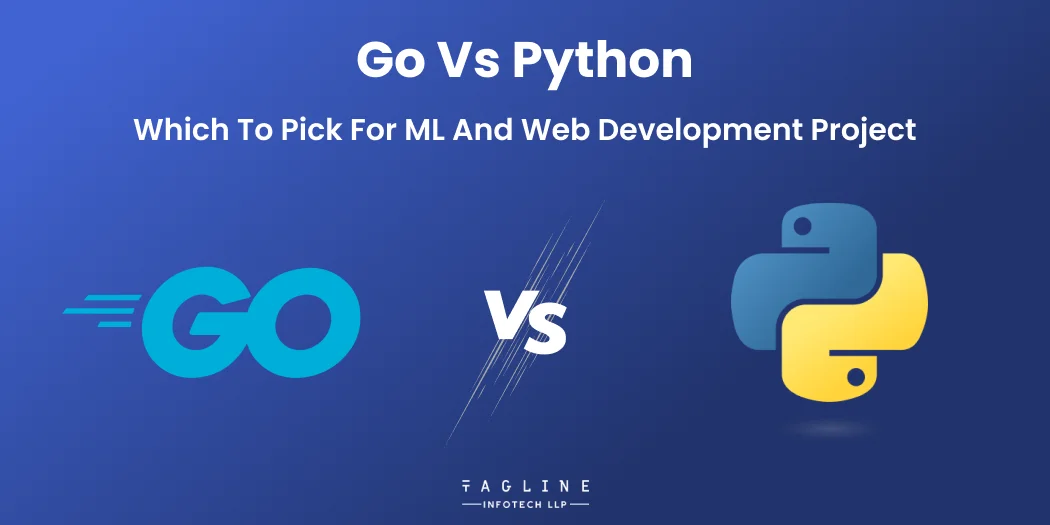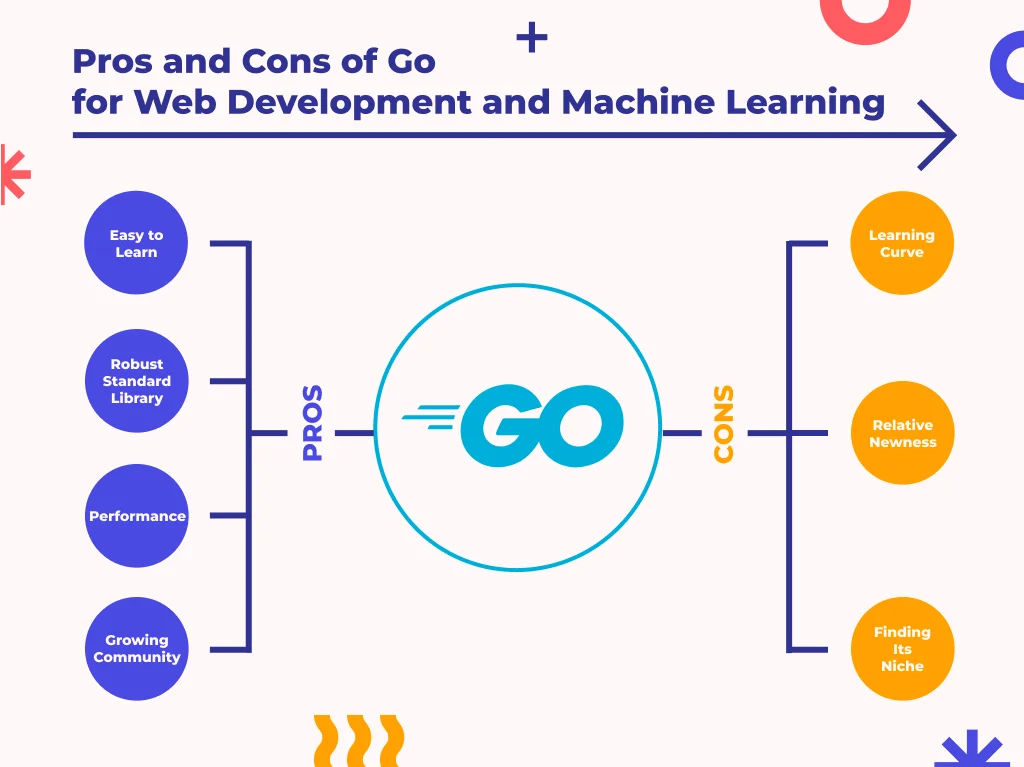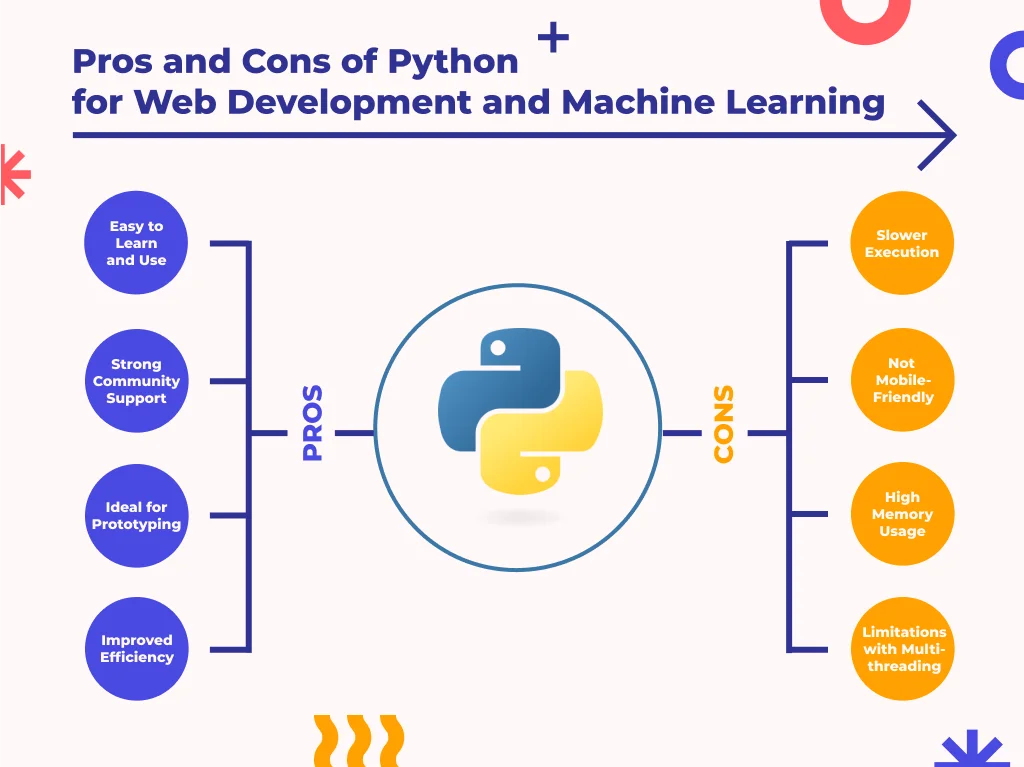Role of Python Libraries in Image Processing
October 30, 2025
Home >> Python >> Go vs Python: Which to Pick for ML and Web Development Project

Quick Summary
Navigating the landscape of programming languages can be a game-changer for businesses striving to elevate their technical capabilities. The task becomes even more complex when your development team is unfamiliar with the technology at hand. In this guide, we will delve into a comparison of two prominent languages, Go vs Python. We’ll examine their roles in web development and machine learning, highlighting their distinctive features and benefits. This analysis will empower you to decide which language aligns best with your project objectives and business aspirations.
Go, commonly known as Golang, was developed in response to challenges faced by Google in the early 2000s. As more users connected to their servers, Google found it increasingly difficult to manage the rising demand. Building large applications like Chrome became time-consuming, often taking hours to compile. Additionally, Google needed a programming language that could efficiently handle vast amounts of text data for web crawling. These needs led to the creation of Go.
Released in 2009, Go is a modern programming language designed to simplify the development of efficient servers and applications that can support high-traffic loads. Drawing inspiration from the C programming language, Go emphasizes ease of use and scalability. With its low memory usage, Go focuses on delivering a straightforward yet powerful tool for developers in search of robust solutions.

It’s no surprise that Google developed its programming language, Go. However, like any tool, it comes with its own set of advantages and disadvantages.
Go offers several benefits that make it an appealing choice for businesses, especially when compared to other programming languages:
Despite its advantages, Go also has some drawbacks that potential users should consider:
Python is one of the most popular programming languages today, and its popularity is well-earned. It stands out because it allows users to write clear, concise code while also supporting the creation of complex, multi-layered programs. Its ease of use makes it somewhat comparable to Go.
Python first appeared in the mid-1990s and was designed to simplify coding. It focuses on reducing the amount of code needed to develop efficient and reliable software. Its simplicity has made it accessible not just for programmers but also for professionals from other fields. For example, data scientists, network engineers, and accountants use Python to analyze large datasets and perform various tasks, showcasing its broad applicability and user-friendly nature. As a result, many businesses turn to a Python development company to harness these advantages and create tailored software solutions.

Python continues to be a top choice among developers, but like any programming language, it comes with its own set of advantages and challenges.
Here are some of the main benefits of using Python for your projects:
However, Python does have its drawbacks:
AI and machine learning are seeing increased use across various industries. According to the 2024 Stack Overflow Developer Survey, only about 6.5% of developers specialize in areas like big data and machine learning, even though interest in these fields continues to grow.
The demand for machine learning expertise is expected to increase even more. As more businesses incorporate ML technology, they’ll be seeking skilled Machine Learning Engineers, leading to numerous job opportunities and competitive salaries for those with the right skills. It’s a promising field for anyone looking to build a career in this area.
According to the 2024 Stack Overflow Developer Survey, Python remains a top language, ranking 3rd with 51% of developers actively using it. Its versatility in web development, data science, and machine learning continues to drive its popularity.
Go, on the other hand, ranks 13th, is used by 9.5% of developers, and is rapidly gaining traction in cloud infrastructure and backend development. Go’s appeal lies in its efficiency and performance for scalable systems.
While Python is a general-purpose favorite, Go’s strengths in concurrency and cloud projects make it a growing choice for specific domains.
Both Go and Python have specific strengths for web development and machine learning, making them popular for different types of projects. Here’s a unique breakdown of their standout features:
When deciding between Python and Go, it’s essential to consider your project’s goals: Python is highly flexible and simple, while Go excels in performance and scalability, making it ideal for cloud-based and large-scale applications.
When comparing Go and Python, it’s essential to look beyond the technical specifications and dive into how these languages perform in real-world scenarios. Factors like speed, scalability, execution libraries, and overall project efficiency all play a role in determining the best fit for your needs.
Python has been a versatile programming language for over two decades, and it is used across various industries. Nearly 50% of developers globally use it regularly, making it one of the top five programming languages.
In comparison, Go (Golang) has yet to achieve similar adoption. By 2021, about 2.5 million developers had chosen Go, but its popularity declined slightly in 2022.
Python is particularly dominant in North America, India, and Western Europe, while Go is more popular in Asia and Oceania, with over 700,000 developers using it.
Choosing between the two depends on performance, community support, and specific project goals.
To compare Python and Go’s performance, complex mathematical equations are often used to test memory management and processing time.
Go, designed with speed and efficiency in mind, outperforms Python in such tests. Its use of “goroutines” allows for lightweight, efficient handling of multiple tasks simultaneously, making it ideal for high-performance applications.
This focus on reliability and speed is why many developers choose Go over Python when building resource-heavy software. While Python remains simpler and versatile, Go excels in tasks where performance is key.
Frameworks are essential tools that help speed up the development of websites and apps. Python stands out with its vast selection of open-source, cross-platform frameworks like Django and Flask, which simplify the development process. In contrast, Go doesn’t have a built-in framework specifically for software development.
The use of Golang Web Frameworks depends heavily on the project’s technical requirements. Ultimately, the best choice between Go and Python depends on the project’s needs and the client’s preferences.
As applications grow, scalability becomes crucial. Python is popular in both large-scale and startup projects but struggles with parallel processing, affecting performance at massive scales. It breaks tasks into subtasks, which can be resource-intensive.
Go, however, excels with its built-in concurrency, enabling simultaneous task execution, making it ideal for large-scale projects where performance and scalability are key.
In terms of scalability, Go is the stronger choice, especially in resource-demanding environments.
Each programming language has its strengths in specific fields, like web development, AI, and cloud computing. Go and Python differ in their application areas based on their capabilities and supporting libraries.
Python is widely used in:
Python’s extensive libraries make it a popular choice in these fields, allowing developers to build complex solutions with ease.
On the other hand, Golang (Go) excels in systems programming but is also used in:
Go’s strengths lie in its concurrency support, fast performance, and easy-to-use libraries, making it ideal for projects that require speed and efficiency.
Overall, Go’s speed and concurrency make it a solid choice for server-side and cloud-based applications, while Python remains dominant in data-driven and AI-related fields.
A key difference between Go and Python is how they execute code. Go is statically typed, requiring explicit variable declarations, which helps catch type-related errors and simplifies debugging. In contrast, Python is dynamically typed, allowing types to be inferred at runtime, which increases flexibility but also the risk of undetected bugs.
For large applications, Python’s dynamic nature can lead to errors, while Go’s static typing provides a more structured approach, making it better suited for developers focused on performance and accuracy.
Golang, as a newer player in web development, has a more limited library ecosystem compared to Python, which has a long-standing presence. However, Go’s core packages support rapid and efficient development for web applications, lightweight apps, and cloud solutions.
If your project involves large datasets or requires a variety of libraries, Python is preferable. With over 140,000 libraries, Python excels in data science, machine learning, data visualization, and image processing.
In terms of library offerings, Python 3.11 surpasses Go, providing extensive resources for diverse challenges.
Code readability is vital, especially in team environments. Python is known for its readability, but its flexibility can sometimes confuse due to multiple ways to achieve the same result.
In contrast, Go emphasizes clarity with stricter coding standards, minimizing misinterpretation and providing a specific way to complete tasks.
While Go is primarily used by experienced developers, Python ranks among the top five programming languages, offering substantial community support and resources. This gives Python an advantage, but Go’s structured approach enhances readability for those familiar with its conventions.
Python is an excellent choice for creating software prototypes due to its flexibility and simplicity. Its user-friendly nature enables developers to build a Minimum Viable Product (MVP) quickly, even with limited programming skills or resources.
On the other hand, Go, being a statically typed language, requires more programming expertise. This can make the prototyping process more challenging, even for simpler projects like lightweight authentication microservices.
Both Python and Go can be utilized for machine learning development, but Python is often seen as the better option in this domain. This is primarily due to its extensive libraries, which provide a diverse range of machine-learning algorithms, model implementations, and prediction tools.
While Go is a robust language, it still falls short in terms of available resources and libraries for machine learning. Additionally, Go’s more complex debugging and stricter typing can make it less attractive for machine learning projects compared to Python.
When it comes to deep learning, Golang is not as commonly used as other languages. While there are some libraries like GoLearn and Goml, they lack the comprehensive structures needed to handle complex projects effectively.
The limited availability of Go-based frameworks and libraries makes deep learning development more challenging, especially when compared to the rich ecosystem provided by Python.
Historically, Python for Data Analysis and Data Science has been the go-to language. Its extensive frameworks and libraries support various fields, including mathematics, artificial intelligence, statistics, and distributed processing, making it ideal for launching data-driven projects.
Although Golang is starting to make inroads into AI technologies, it is still relatively immature in the realm of data science and lacks the necessary community support to compete with Python’s established presence.
Both Go and Python have unique strengths and weaknesses. Here’s when to choose each:
Python is perfect for user-focused applications, such as web apps and data analysis tools. Its simplicity and readability enable quick development and iteration, making it ideal for projects involving user interaction.
Go excels in server-side applications, particularly for high-performance systems like microservices. Its efficiency and concurrency make it suitable for projects requiring speed and scalability.
Python is often chosen by businesses that prioritize web development, data analysis, and quick prototyping due to its rich library support and user-friendly nature. Go is preferred for applications that require high performance, scalability, and efficient concurrency, making it suitable for microservices and systems programming. The decision between Python and Go ultimately hinges on the specific requirements of your project and the development ecosystem you aim to work within.
Both Go and Python are strong contenders for web app development, each offering distinct advantages. Go is known for its reliability and efficiency, making it perfect for high-performance applications. On the other hand, Python excels in flexibility, particularly for developing comprehensive solutions like ERP systems that manage everything from business operations to data analytics.
To find the right technology stack for your project, start by defining your software architecture based on your specific needs. This will help you decide whether Go or Python is the better fit for your goals.
If you’re tackling a machine learning project and debating whether to use Go or Python, our team of experienced Machine Learning Engineers is here to help. We can guide you in making the best choice and achieving exceptional results. For expert support, consider Hiring Python Developers from Tagline Infotech, a leading Python Development Company to ensure your project’s success.
If you’re starting, Python is often easier due to its simplicity and numerous frameworks (like Django and Flask). However, Go is great for building high-performance web applications, especially if you need concurrency and speed.
Switching depends on your goals. If you’re focusing on web services or performance-critical applications, Go can be beneficial. However, if you’re involved in data science or rapid prototyping, sticking with Python might be better.
Go is generally considered more complex due to its strict typing and concurrency model. Python, with its straightforward syntax, is often easier for beginners to grasp.
This decision hinges on your interests. If you enjoy building applications and user interfaces, web development may be the way to go. If you’re more interested in data analysis and predictive modeling, then machine learning is a great choice.
Created with Solvase

Digital Valley, 423, Apple Square, beside Lajamni Chowk, Mota Varachha, Surat, Gujarat 394101
D-401, titanium city center, 100 feet anand nagar road, Ahmedabad-380015
+91 9913 808 2851133 Sampley Ln Leander, Texas, 78641
52 Godalming Avenue, wallington, London - SM6 8NW